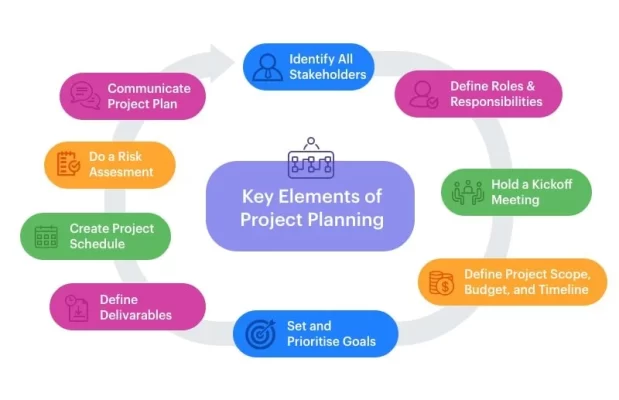Made during the project planning stage, it is a combination of various previous records. Though it does incorporate those things, it is more than just a calendar or a task list. Formally accepted at the start of the project, the project management plan is then constantly revised during the course of the project.
Why Should One Pay Attention to Project Planning ?
In project management, project planning is a vital phase that follows initiation. By means of appropriate planning, you simplify the whole project into a set of actions and guarantee the timely availability of all the resources.
The process of project planning addresses project restrictions like time, scope, and finances; after possible hazards are found, mitigating strategies are created. Comparing the real development with the project schedule helps you to keep an eye on team performance and guide the required actions to raise it.
How to Design an Online Project Schedule ?

If you are considering, “Well, that sounds really formal and serious,” don’t be intimidated.
Using these nine project management techniques can help you not only with project planning but also with project execution, ensuring your success in all areas.
1. List All Those Involved
There are various stakeholders in your project; not all of them will be involved in every aspect of it. Project participants consist of:
- Your client, the end users of the good, the business and its executives, and the staff directly involved on the project.
- Stakeholders depending on the type of project could also include outside companies or local residents impacted by the project.
2. Specify Positions and Obligations
After you have named your stakeholders, you must decide the fundamental project management techniques and competencies the project calls for. Having such a list helps you to create roles and distribute tasks among particular stakeholders.
Recall that a role differs from a person.
Sometimes one person can play several roles, including a designated emergency contact, a job that adds a few more work hours to a person’s calendar. In other situations, several persons might be in the same roles—as in your project calling for several software developers. Typical positions consist of:
- Project manager
- Project sponsor
- Project team members
Your project will determine the various project team member duties, but be sure to include customer relations and vendor relations roles.
3. Organize a Kickoff Conference
The launch conference is a chance to unite all project stakeholders, create a vision for the project everyone can support, and create positive working ties through introductions.
Your meeting agenda should contain a discussion of the project scope, budget, timeframe, and objectives as at this point the particular elements of the project haven’t been decided. This is also the time for announcements of jobs and a justification of a communication strategy. For the whole project, the working relationship among the stakeholders is shaped by the inaugural conference.
4. Specify Project Scope, Budget, and Schedule
Following the formal kickoff, it is time to outline three key ideas:
- The extent of your project
- Its budget
- Its schedule
We will simply define each of these objects here since each one is deserving of its own in-depth discussion.
Project scope guides our actions—that is, what are we going to do (and not)? What are the goals of this project considering the needs of the client and the team’s shared vision?
- Budget: What is the projected financial cost of the project considering the extent and the resources needed to satisfy the project objectives? Still, it’s crucial not to pass over chances to cut costs, including using discounts like those NamoBOT highlights.
- Schedule: The project timetable itemizes your project’s phases and the length of time you could reasonably expect them to be completed.
5. Create and Rank Objectives
Once your staff knows the goals of the project and you have decided on the phases to help reach those goals:
- Divide the overall goals of your project into smaller, more manageable tasks.
- Prioritize chores based on priority and dependencies.
- Set up a mechanism to guarantee remedial action should goals not be timely completed.
Given your objectives, you might have to change your schedule.
6. Specify Deliverables
A good, consequence, or talent.
An essential component of the project strategy, project deliverables are decided upon by the project objectives. Should the customer want end users to manage their own content, for instance, the deliverables might include a piece of software that allows users to manage the content as well as training materials for staff members and end users on how to utilize the freshly developed software.
7. Create a Project Calendar
A project schedule is a record of specifics that includes:
- The project schedule
- The organizational tools needed to finish every activity
- Any other data vital for the team management
It must, naturally, be thorough and easily understandable.
To generate a project schedule:
- Separate the phases of your project into discrete tasks and activities.
- Identify dependencies.
- Arrange the activities.
- Project the necessary resources and length of each task.
The data you gather during this process could point up required changes in your responsibilities, schedule, or budget. This is a necessary phase of the process and a key component of developing a basic project plan in writing. Making these tweaks before the job starts is far preferable than weeks or months later.
8. Perform a Risk Analysis
A risk is a problem likely to develop during your endeavor. In project management, risk identification and mitigation are crucial rather than waiting to be discovered later. Call a meeting or solicit advice from every team member regarding the hazards you should consider.
Risk-prone areas include:
- Project Scope
- Resources: physical, financial, and personnel aspects
- Project postponements and technological or communication failure
Though it is impossible to eliminate all possible hazards, careful planning helps you avoid project failure.
9. Share the Project Schedule
Make sure the team and any other involved parties completely understand your project strategy after you have it developed. As you compiled your project schedule, you might have developed a project communication plan. If not, get right now!
Establishing strong channels of contact and project communication expectations is vital. Being accredited by PMP, as a project manager, make sure you set an example of the kind of open communication you hope from every participant.
Main Elements of the Strategy for Managing Projects
A project plan at its most basic comprises three elements. Making a list of all these elements can assist you in guiding your project management strategy.
-
Exercises: What actions will your staff have to do to finish the project? Your project schedule calls for activities including stuff like assessing development, assigning duties, distributing funds, time monitoring spent on project activities, and efficient communication. Any task management starts a project with tasks broken out. These are little tasks that add up to make your project whole. Establishing your project management strategy depends on knowing these chores; having small targets helps you measure success and solve problems.
-
Materials: With what are you working? Naturally, among your resources is your budget. Additionally crucial is knowing your needs for both human and material resources. Will you be using subcontractors or temporary workers for this project? How many individuals will be needed working on it? Which digital or physical resources are needed, and from whence will those items originate?
How May Project Planning Applications Support Project Development ?
A good project management plan entails efficient arrangement of all the resources, tasks, and activities comprising your project. It is time-consuming and ineffective to try to accomplish all of this using a collection of spreadsheets poor for project management and shared documents, or worse, using notebooks, pens, and sticky notes.
From start to finish, project planning tools may streamline your project planning and provide project management tools and project transparency, enabling you to not only produce a first-rate project management plan but also effectively run your project. Good project management tools free time to concentrate on the real project by enabling faster and more efficient performance of administrative chores.
Effective communication both inside and across teams can also be facilitated by project management software; it helps you track important performance criteria, centralize all project data, and create reports on your project as it is developing. Many of your project management problems—especially with regard to planning can be resolved with a competent and effective project management tool.


